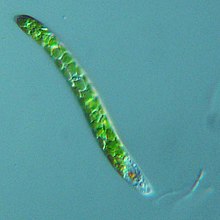Euglenales: Difference between revisions
added nomenclatural note |
added description |
||
| Line 14: | Line 14: | ||
== Nomenclature == |
== Nomenclature == |
||
The order Euglenales is also known by the name Euglenida. The origin of this dual naming system is because of the history of protists. Euglenids have been treated as both [[algae]] and [[protozoan]]s, which are governed by separate [[nomenclature codes]].<ref name=Patterson>{{cite journal | doi= 10.1111/j.1550-7408.1992.tb01292.x | title= A Perspective on Protistan Nomenclature | year= 1992 | last1= Patterson | first1= David J. | last2= Larsen | first2= Jacob | journal= The Journal of Protozoology | volume= 39 | pages= 125–131 }}</ref> If classified as an alga, it would fall under the [[International Code of Botanical Nomenclature]] (ICBN) and its correct name would be Euglenales; if classified as a protist, it would fall under the [[International Code of Zoological Nomenclature]] (ICZN) and would be called Euglenida.<ref name=Kostygov_2021/> Euglenids such as these are considered to be [[ambiregnal protist]]s due to their parallel naming systems.<ref name=Patterson/> |
The order Euglenales is also known by the name Euglenida. The origin of this dual naming system is because of the history of protists. Euglenids have been treated as both [[algae]] and [[protozoan]]s, which are governed by separate [[nomenclature codes]].<ref name=Patterson>{{cite journal | doi= 10.1111/j.1550-7408.1992.tb01292.x | title= A Perspective on Protistan Nomenclature | year= 1992 | last1= Patterson | first1= David J. | last2= Larsen | first2= Jacob | journal= The Journal of Protozoology | volume= 39 | pages= 125–131 }}</ref> If classified as an alga, it would fall under the [[International Code of Botanical Nomenclature]] (ICBN) and its correct name would be Euglenales; if classified as a protist, it would fall under the [[International Code of Zoological Nomenclature]] (ICZN) and would be called Euglenida.<ref name=Kostygov_2021/> Euglenids such as these are considered to be [[ambiregnal protist]]s due to their parallel naming systems.<ref name=Patterson/> |
||
== Description == |
|||
Euglenales consists mostly of freshwater organisms, in contrast to its sister [[Eutreptiales]] which is generally marine. Cells have one emergent [[flagellum]] (plus an additional vestigial flagellum),<ref name=Kostygov_2021/> in constrat to Eutreptiales with emergent flagella.<ref>{{cite journal | doi=10.1186/1471-2148-12-29 | title=Morphostasis in a novel eukaryote illuminates the evolutionary transition from phagotrophy to phototrophy: Description of ''Rapaza viridis'' n. gen. et sp. (Euglenozoa, Euglenida) | year=2012 | last1=Yamaguchi | first1=Aika | last2=Yubuki | first2=Naoji | last3=Leander | first3=Brian S. | journal=BMC Evolutionary Biology | volume=12 | page=29 | pmid=22401606 | pmc=3374381 }}</ref> |
|||
== References == |
== References == |
||
Revision as of 19:41, 17 May 2023
| Euglenales | |
|---|---|

| |
| Euglena mutabilis | |
| Scientific classification | |
| Domain: | Eukaryota |
| Phylum: | Euglenozoa |
| Class: | Euglenida |
| Clade: | Euglenophyceae |
| Order: | Euglenales F.Stein, 1878 |
| Families | |
Euglenales (also known as Euglenida) is an order of flagellates in the phylum Euglenozoa. The family includes the most well-known euglenoid genus, Euglena, as well as other common genera like Phacus and Lepocinclis.[1]
Nomenclature
The order Euglenales is also known by the name Euglenida. The origin of this dual naming system is because of the history of protists. Euglenids have been treated as both algae and protozoans, which are governed by separate nomenclature codes.[2] If classified as an alga, it would fall under the International Code of Botanical Nomenclature (ICBN) and its correct name would be Euglenales; if classified as a protist, it would fall under the International Code of Zoological Nomenclature (ICZN) and would be called Euglenida.[1] Euglenids such as these are considered to be ambiregnal protists due to their parallel naming systems.[2]
Description
Euglenales consists mostly of freshwater organisms, in contrast to its sister Eutreptiales which is generally marine. Cells have one emergent flagellum (plus an additional vestigial flagellum),[1] in constrat to Eutreptiales with emergent flagella.[3]
References
- ^ a b c Kostygov, Alexei Y.; Karnkowska, Anna; Votýpka, Jan; Tashyreva, Daria; MacIszewski, Kacper; Yurchenko, Vyacheslav; Lukeš, Julius (2021). "Euglenozoa: Taxonomy, diversity and ecology, symbioses and viruses". Open Biology. 11 (3): 200407. doi:10.1098/rsob.200407. PMC 8061765. PMID 33715388.
- ^ a b Patterson, David J.; Larsen, Jacob (1992). "A Perspective on Protistan Nomenclature". The Journal of Protozoology. 39: 125–131. doi:10.1111/j.1550-7408.1992.tb01292.x.
- ^ Yamaguchi, Aika; Yubuki, Naoji; Leander, Brian S. (2012). "Morphostasis in a novel eukaryote illuminates the evolutionary transition from phagotrophy to phototrophy: Description of Rapaza viridis n. gen. et sp. (Euglenozoa, Euglenida)". BMC Evolutionary Biology. 12: 29. doi:10.1186/1471-2148-12-29. PMC 3374381. PMID 22401606.
{{cite journal}}: CS1 maint: unflagged free DOI (link)
